learning & teaching: test two vocabulary
1/42
There's no tags or description
Looks like no tags are added yet.
Name | Mastery | Learn | Test | Matching | Spaced |
|---|
No study sessions yet.
43 Terms
Chapter 7: Complex Cognitive Processe
-
Metacognition
Knowledge and beliefs about one’s own cognitive processes
develops over time
Greater metacognitive awareness = more likely to use effective strategies, have high achievement
Developmental Trends
Overt strategies
taking notes
creating summaries
Covert strategies
identifying important information
regularly monitoring learning
comprehension monitoring: Checking one's understanding and recall periodically. Ex: Answering some practice questions.
illusion of knowing - In the absence of monitoring learning and comprehension, students may not realize what they know or do not know; consequently, they may think they have mastered something when they have not.
self-explanation: Taking to oneself in the mirror to explain what they’re studying.
self-questioning: Answer some practice questions and do a practice test on quizlet.
Factors Affecting Strategy Use
Learning strategies depend partly on the learning task at hand
Sometimes working memory’s limited capacity discourages metacognitive processing
Cognitive load – cognitive burden that a particular learning activity places on working memory at any one time; includes both the amount of information learners must simultaneously think about and the specific cognitive processes learners must engage in to understand what they’re studying
Students are likely to acquire and use new, more effective strategies only if they realize that their current strategies are not working
Students’ beliefs about the nature of knowledge and learning influence their strategy choices
Epistemic beliefs (epistemological beliefs) – students’ beliefs about the nature of knowledge and learning
Different motives and goals call for different strategies
Students may not have sufficient self-regulation skills to follow up with further study
Self-regulation skills - Learners set explicit goals for themselves through active, intentional strategies.
Ongoing instruction and guidance about effective strategies enhances learning and achievement
Diversity, Disabilities, & Exceptional Abilities
Cultural differences in students’ epistemic beliefs
Students with disabilities may need explicit instruction, scaffolding
Knowledge Transfer
Positive transfer
something we’ve learned before helps us learn something new
Example: Group studying session
Negative transfer
something we’ve learned before makes it harder for us to learn something new
Example: Misunderstanding a rule of physics from a video on youtude.
Specific transfer
what we learned before overlaps with what we’re learning now
Example: Some English words looking like some words in Spanish.
General transfer
learning in one situation affects learning and performance in somewhat dissimilar situation
Example: Having good study practices affects everything in your education in multiple classes.
Factors Affecting Transfer
Meaningful learning promotes better transfer than rote learning
Both positive and negative transfer are more common when a new situation appears to be similar to a previous one
General principles and theories are more easily transferred than discrete facts and task-specific procedures
Transfer is more common when information and skills are perceived as being relevant to diverse disciplines and real-world situations
context-free material more easily transferred than context-bound
Numerous and varied opportunities for practice increase the probability of transfer
Computer simulations can also provide means of enhancing the probability of transfer
Transfer increases when the cultural environment encourages and expects transfer
Recommendations for Teaching Metacognitive Strategies
Components of Creativity
Fostering Creative Thinking
Show students that creative thoughts and behaviors are valued
Focus students’ attention on internal rather than external rewards
Ask thought-provoking questions
Teach and encourage cognitive and metacognitive strategies that support creative thinking
Give students the freedom and security they need to take risks
Provide the time and resources that creativity requires
Divergent Thinking
Process of mentally moving in a variety of directions from a single idea.
Convergent Thinking
Two components
new, original behavior
productive result
Involves divergent thinking
Fostering Creativity
Show students that creative thoughts and behaviors are valued
Focus students’ attention on internal rather than external rewards
Ask thought-provoking questions
Teach and encourage cognitive and metacognitive strategies that support creative thinking
Give students the freedom and security they need to take risks
Provide the time and resources that creativity requires
Fostering Critical Thinking
Teach fewer topics, greater depth
Encourage intellectual skepticism
Model critical thinking
Provide opportunities to practice
Ask questions
Debate controversial issues
Help students understand that critical thinking involves considerable mental effort, but it’s worth it
Embed critical thinking skills in authentic activities
Require use of critical thinking in classroom assessment tasks
Chapter 8: Learning and Cognition in Context
-
Creating a Community of Learners
All students are active participants in classroom activities
The primary goal is to acquire a body of knowledge on a specific topic, with students contributing to and building on one another’s efforts
Students draw on many resources in their efforts to learn more about the topic
Discussion and collaboration occur regularly and play key roles in learning
Diversity in students’ interests and rates of progress is expected and respected
Students and teacher coordinate their efforts in helping one another learn; no one has exclusive responsibility for teaching others
Everyone is a potential resource for others
The teacher provides some guidance and direction for classroom activities, but students may also contribute guidance and direction
Mechanisms are in place through which students can share what they have learned with others
Constructive questioning and critiquing of one another’s work is commonplace
The process of learning is emphasized as much as—and sometimes more than—the finished product
Cultures as Contexts
Culture
Behaviors and beliefs that are passed from old members of a social group to new ones, from generation to generation.
Facilitates survival and progress
Both concrete and abstract
Schemas & Scripts
Schemas
organized set of facts about a specific topic (e.g., schema for horses)
Scripts
schema involving predictable sequence of events related to a common activity (e.g., script for doctor’s visit)
Influenced by culture
Worldviews
Worldviews
General sets of beliefs and assumptions about reality
culturally transmitted
often encompass implicit knowledge
may conflict with academic subject matter
Chapter 2: Cognitive and Linguistic Development
-
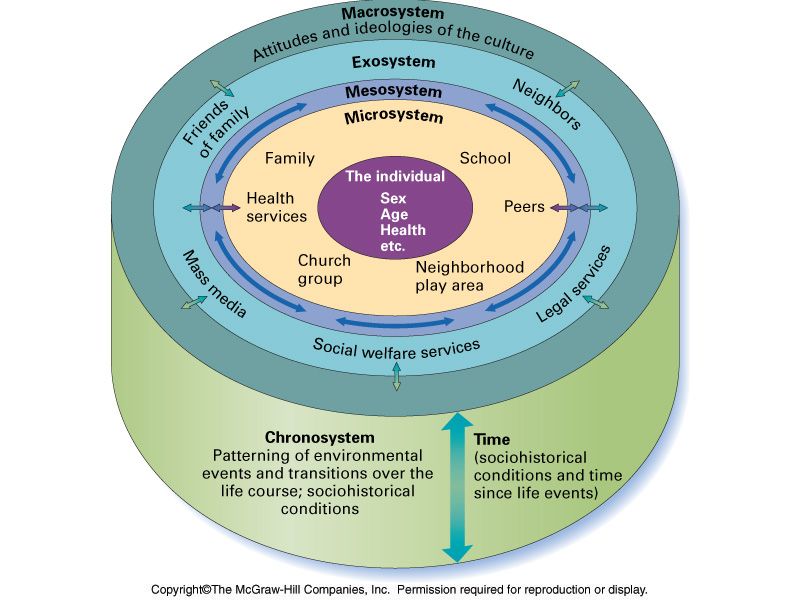
Bronfenbrenner’s Ecological Theory of Development
Is a psychological theory that explains how social environments affect children’s development. The theory views child development as a complex system of relationships affected by multiple levels of the surrounding environment, from immediate family and school settings to broad cultural values, laws, and customs. The theory also emphasizes that a child’s own biology is a primary environment fueling her development.
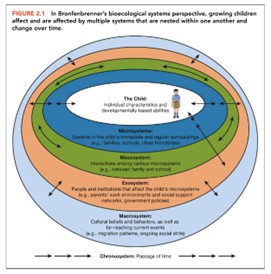
Piaget’s Theory of Cognitive Development
Assimilation
dealing with a new object or event in a way consistent with a currently existing scheme
Accommodation
schemes must be adjusted when new information doesn’t fit
Stages of Cognitive Development
Piaget proposed that children move through four stages.
Periods of time are consistent in age and developmental sequence.
Age ranges are averages.
Some children are in transition from one stage to the next.
Sensorimotor Stage (birth – 2)
Begins with reflexes & sensorimotor schemes
Goal-directed behavior emerges: Reaching out for a toy.
Object permanence emerges: When peekaboo don’t amuse the child anymore.
Symbolic thought emerges
transition to new stage
Preoperational Stage
Symbolic representation
Limited mental manipulation (operations)
Preoperational egocentrism: Inventing an imaginary friend
failure to conserve: Regardless of alterations in shape or arrangement, the amount remains the same if nothing is added or taken away.
Age 2 to about age 6 or 7
Concrete Operations Stage
Some mental manipulation & logical thought
can conserve
can learn classification, seriation
can reverse operations
allows for the teaching of mathematics
Difficulty with abstract and counterfactual ideas: Complex math problems. Ex: Algebra
Age 6-7 years until 11-12 years
Formal Operations Stage
Abstract & scientific reasoning
Hypothetical ideas
Contrary-to-fact ideas
Adolescents also become more idealistic
formal operational egocentrism
Vygotsky’s Sociocultural Theory
Zone of proximal development
the experience of a learner who works successfully with the support of another and extends their knowledge in the process
Cognitive tool: A culturally constructed tool, such as a concept, symbol, or strategy, that enhances effective problem-solving and decision-making. Ex: Classifying and sorting
Self-talk: A cognitive process that involves talking to oneself as a way of guiding oneself through a task. It is an effective technique for improving performance and self-regulating behaviors. Ex: Practicing a presentation.
Inner speech: This refers to the act of having an internal dialogue in one’s own mind, which can involve talking through problems, analyzing situations, or simply thinking about one’s day. Ex: Planning where to eat after studying at the library.
Internalization: Gradual incorporation of socially based activities into cognitive processes. Ex: Quietly doing your classwork.
Zone of proximal development: With guidance, a learner can perform tasks outside their ability to perform independently. Ex: Learning to study and finding what works for you.
Actual developmental level: The upper limit refers to the maximum number of tasks that a learner can proficiently perform without external assistance. Ex: Multitasking while studying or doing classwork.
Scaffolding: Assistance mechanism provided to a learner for successfully completing a challenging task within their ability level. Ex: Overcoming procrastination.
Ch.3: Personal and Social Development
-
Development of Peer Relationships and Interpersonal Understanding
Friends
Mutually invested in relationship emotionally
Usually similar in age & sex
Tend to share similar interests
Friendship helps develop perspective-taking and other social skills
Cliques
exclusive in nature
3 to 10 members
Crowds
larger than cliques, not as exclusive
share activities, attitudes, or background
can take form of subculture
Subculture
cohesive group
characterized by initiation rites, distinctive clothing, & other markers
Romantic Relationships
Usually evolve from crush to real love
Often based on attractiveness, social status
Offers developmental benefits
companionship, affection, and security
opportunities to experiment with new social skills and interpersonal behaviors
May be confusing in adolescence
sexual feelings & intimacy
LGBTQIA+ (lesbian, gay, bisexual, transgender, queer or questioning, intersex, asexual or ally, and others)
Questioning teens may experience depression while others enjoy good mental health with supportive school and home environments
Popularity & Social Isolation
Popularity & Social Isolation
Popular students
may or may not have high status
considered kind, trustworthy by peers
Rejected students
considered undesirable social partners
often have poor social skills
may be harassed and/or disengaged
Controversial students
some peers like, some dislike
usually have good social skills
Neglected students
almost seem “invisible” to peers
higher risk for depression
Social Cognition
Social Cognition
Ability to think about how other people are likely to think, act, and react
perspective taking
theory of mind
social information processing
Development of Social Cognition
Childhood
some awareness of others’ “inner worlds”
understanding that desires, beliefs, intentions can differ
understanding that people can mask true feelings, thoughts
Early adolescence
understanding that people can have mixed feelings
development of recursive thinking – thinking about what other people may be thinking about oneself, possibly through multiple iterations
Late adolescence
“budding psychologist”
Aggression
Actions intended to harm others
physical aggression: Action that can potentially cause bodily injury.
psychological aggression: Consequence that seriously threatens self-esteem and general psychological well-being.
proactive vs. reactive aggression: proactive- deliberately aggressive behaviors to obtain desired goals. reactive aggression- deliberately aggressive behaviors in response to frustration or provocation.
Factors influencing aggression
genetic predisposition
poor perspective-taking skills
misinterpretation of social cues
prevalence of self-serving goals
ineffective social problem-solving strategies
beliefs about appropriateness and effectiveness of aggression
Technology & Peer Relationships
Cell phones, social networking sites, IM
Benefits
can enhance self-esteem
provides connectedness with peers
increase in psychological well-being
Risks
relational aggression & cyberbullying
misrepresentation of identity
Promoting Healthy Relationships
Provide opportunities for social interaction, cooperation
Help students interpret social situations
Teach specific social skills, provide opportunities for practice, give feedback
Promote understanding, communication, interaction
Explain what bullying is and why it cannot be tolerated
Help change the reputations of formerly antisocial students
Create a general climate of respect for others
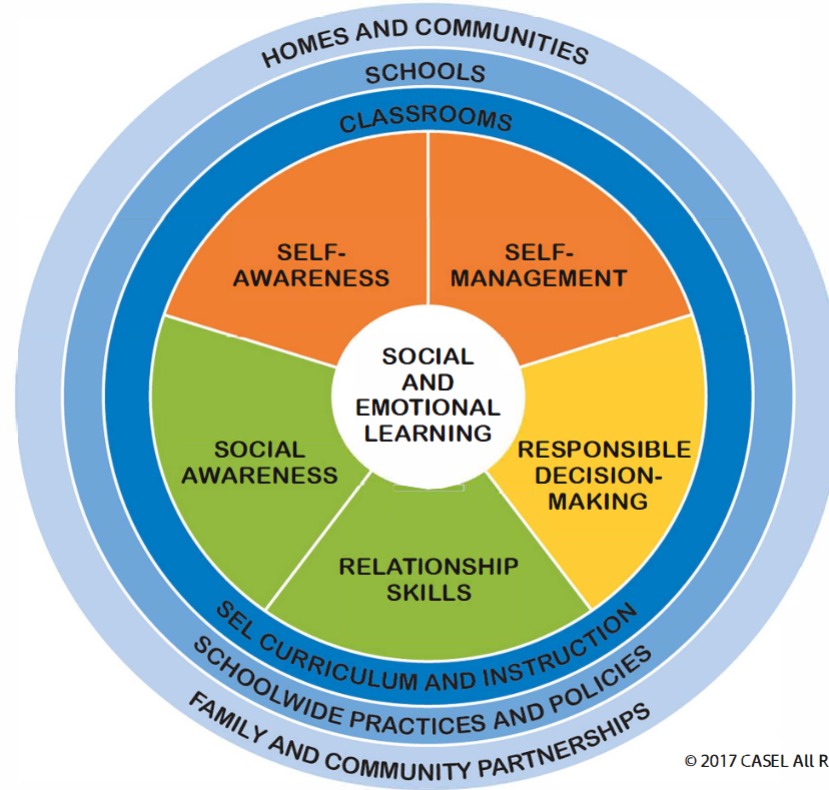
Social and Emotional Learning
-
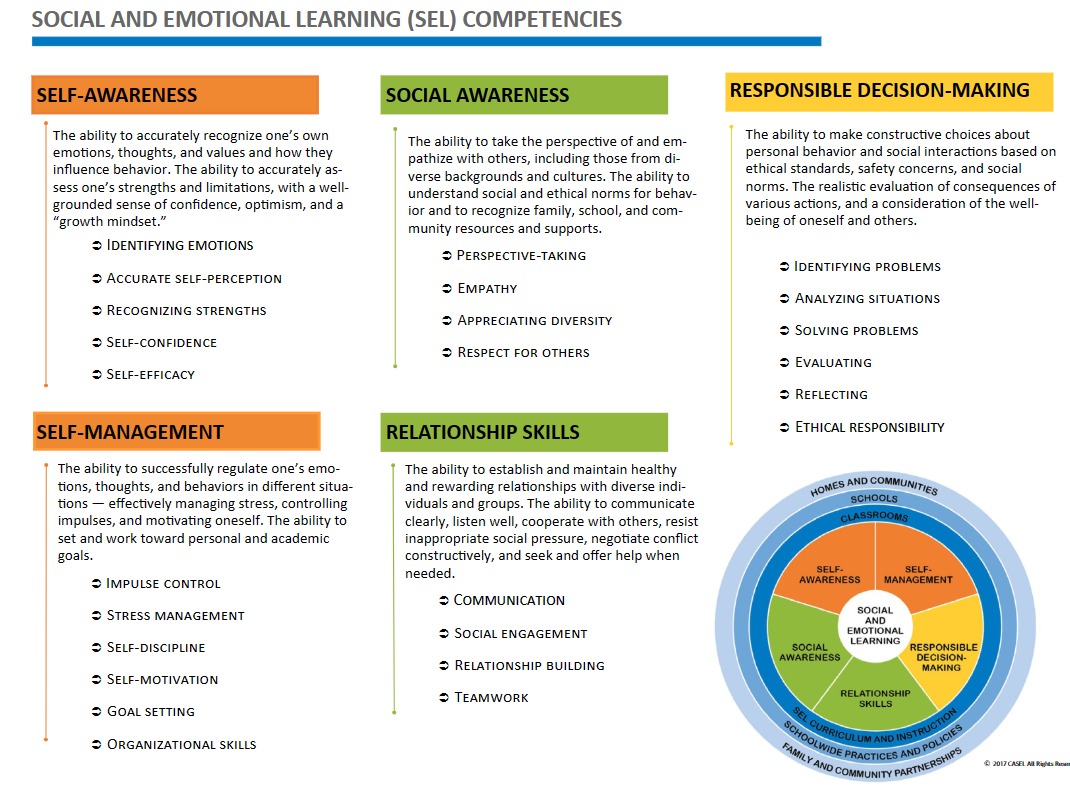
Factors Affecting Personality Development
Personality – characteristic ways in which a particular individual behaves, thinks, and feels in a wide range of circumstances
Result of both heredity and environmental factors
Temperament
General predisposition to respond in particular ways to one’s physical and social environments
genetically based
persist across lifespan
Family Dynamics
Attachment
strong, affectionate bond between child and caregiver
Parenting style
authoritative: A form of parenting with emotional warmth, high standards for behavior, explanation and consistent enforcement of rules, and inclusion of children in decision-making.
authoritarian: A form of parenting with rigid rules and expectations for behavior to make children obey without question.
permissive: A form of parenting allowing excessive freedom of behavior and imposing few consequences for inappropriate actions.
neglectful or abusive (child maltreatment): Consistent neglect or abuse of a child endangering the child’s physical and psychological well-being.
Development of a Sense of Self
Sense of self – perceptions, beliefs, judgments, and feelings about oneself as a person; includes self-concept and self-esteem
Sense of Self
assessments of one’s own characteristics, strengths, and weaknesses
e.g. Knowing your self-esteem
Self-Esteem
judgments and feelings about one’s own value and worth
e.g. How you fit into the beauty standard
Factors Influencing Sense of Self
Previous performance
self-efficacy based on success and failure
Behaviors of others
comparison of self with peers
others’ expectations and feedback
Group memberships and achievements
peers, family, culture
Chapter 11: Motivation and Affect
-
Key Terms
Motivation: Provides energy, influences behavior, and keeps people motivated. It motivates people to move forward and emphasizes a specific direction. Ex: Keeping up good grades to keep scholarships that pay for university.
Time on task: A factor affecting a student's learning and achievement. Ex: Working a job outside of school.
Extrinsic motivation: Participates in an activity to earn a reward or to avoid punishment external to the activity. Ex: In kindergarten, the teacher asks you to take a form home for your parents to sign and bring it back the next day to receive a treat.
Intrinsic motivation: It is an enjoyable and interesting activity that motivates one to engage in it; that is, the motivation to engage is internal to the activity. Ex: Passionate about a topic in social justice and writing about it for class.
Flow: The process of completely absorbing and focusing on a challenging activity, an intense form of intrinsic motivation. Ex: Reading up on and researching about that social justice issue that you feel passionate about.
Carol Dweck’s Research on Praise
Found that children who were praised for working hard were more motivated to take on challenging problems, became more confident in their abilities, and enjoyed solving problems more than children who were praised for being smart. When kids receive praise that’s focused on their efforts, it boosts their sense of agency.
Growth mindset: The belief that one can learn complex topics by practicing and working hard.
Fixed mindset: The belief that one doesn’t have the ability to learn in certain areas.
Learned helplessness: The belief that one is incapable of doing a task and has little or no control of the environment.
Basic Human Needs: Maslow’s Hierarchy
Is an early model regarding human needs, proposing that humans organize their needs in consistent ways.
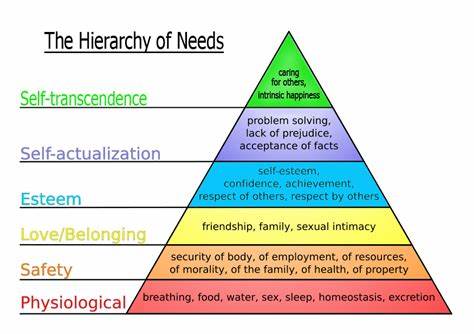
How Learners Attribute Intelligence Influences…
Learners’ emotional reactions to success and failure
Expectations for future success and failure
Effort and persistence
Learning strategies and classroom performance
Developmental Trends
With age, children distinguish between various possible causes of their successes and failures, including effort and ability
How Teacher Attributions and Expectations Affect Students’ Achievement
Teacher beliefs are strongly related to teachers’ interactions with their students.
Teachers’ attributions for students’ current behaviors affect their expectations for students’ performance.
usually formed early in the year
often reflect fixed mindset
communicated to students in explicit or subtle ways
Affect both motivation and achievement
Can lead to self-fulfilling prophecy
Expectations for an outcome either directly or indirectly lead to the expected result
What teachers expect students to achieve becomes what students actually do achieve
Can lead to teacher support and appropriate assistance
Teacher Expectations: Forming Productive Attributions and Expectations for Student Performance
Remember that teachers make a difference.
Look for strengths in every student.
Consider multiple explanations for low achievement, classroom misbehavior.
Communicate optimism about what students can accomplish.
Objectively assess students’ progress.
Attribute successes to high ability and controllable factors.
Attribute successes to effort only if effort is considerable.
Attribute failures to controllable, easily remedied factors.
When students fail despite obvious effort, attribute failures to lack of effective strategies; help them acquire such strategies.
Affect and Its Effects
Emotions, general moods that a learner brings to bear on a task
Facilitative Anxiety vs. Debilitative Anxiety
Facilitating anxiety is little anxiety that leads the learners into action, while debilitating anxiety is a mass amount of anxiety that interferes with performance. The difference between facilitating and debilitating anxiety is the amount of anxiety. Facilitating anxiety example: Completing a small assignment. Debilitating anxiety example: Studying for huge final exam.